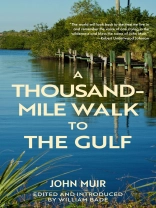A Thousand-Mile Walk to the Gulf, John Muir’s captivating and lyrical travelogue, chronicles his remarkable 1867 journey from Indiana through Kentucky, Tennessee, North Carolina, Georgia, and Florida to the Gulf Coast. Muir draws on his diaries to deliver a vivid and evocative portrayal of the natural world, as well as the people and towns he encountered in the American South in the aftermath of the Civil War. Muir’s passionate love of nature is on full display in this beautifully written tribute, which serves as a testament to the transformative power of travel and the enduring importance of preserving our natural heritage. This Warbler Classics includes sketches by Muir that appeared in the first edition of the book and a detailed biographical note.
Содержание
Contents
Illustrations
Introduction
Chapter I. Kentucky Forests and Caves
Chapter II. Crossing the Cumberland Mountains
Chapter III. Through the River Country of Georgia
Chapter IV. Camping Among the Tombs
Chapter V. Through Florida Swamps and Forests
Chapter VI. Cedar Keys
Chapter VII. A Sojourn in Cuba
Chapter VIII. By a Crooked Route to California
Chapter IX. Twenty Hill Hollow
Biographical Note
Об авторе
John Muir (1838-1914) was a Scottish-born American naturalist, writer, and advocate of U.S. forest conservation. As early as 1876 Muir urged the federal government to adopt a forest conservation policy. In 1890, due in large part to Muir’s efforts, an act of Congress created Yosemite National Park. In 1892 Muir and a number of his supporters founded the Sierra Club, an organization devoted to protecting the environment. He served as its first president, a position he held until his death in 1914. Muir’s personal involvement was instrumental in the establishment of many of the country’s other national parks: Sequoia National Park, the Petrified Forest, Muir Woods National Monument, and Grand Canyon National Park. John Muir died in Los Angeles on December 24, 1914, of pneumonia at the age of seventy-six. His writings continue to serve as sources of inspiration for naturalists and conservationists the world over and remain important works in the body of literature on America’s natural history.












